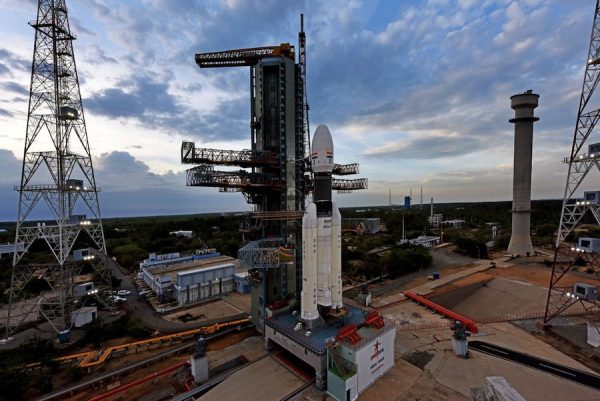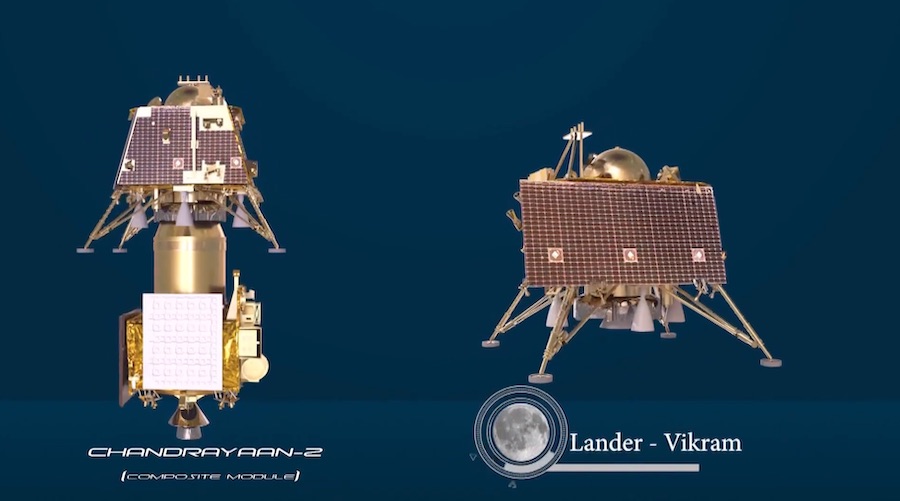Indian moon launch rescheduled for Monday – Spaceflight Now

India’s robotic Chandrayaan 2 moon mission is set for liftoff Monday after a technical snag last weekend halted the launch from a spaceport on the Indian coast, ISRO said Thursday.
The three-piece moon mission, comprising an orbiter, lander and rover, was set for blastoff last Sunday aboard India’s GSLV Mk.3 rocket. But a technical problem on the GSLV Mk.3’s cryogenic upper stage forced officials to call off the launch in the final hour of the countdown.
Reports from Indian media suggested the problem, apparently related to the cryogenic stage’s helium pressurization system, proved relatively easy to fix.
The Indian Space Research Organization announced the new target launch date in a tweet early Thursday. ISRO faces a short launch window to get the Chandrayaan 2 mission off the ground, and still have time for the spacecraft to reach its planned landing site in early September.
Liftoff is set for 0913 GMT (5:13 a.m. EDT) Monday from the Satish Dhawan Space Center, located on Sriharikota Island on India’s southeastern coast around 50 miles (80 kilometers) north of Chennai.
Around 16 minutes after liftoff, the 142-foot-tall (43.4-meter) GSLV Mk.3 rocket will loft the Chandrayaan 2 spacecraft into an elliptical orbit around Earth, ranging as high as 24,000 miles (39,000 kilometers) at its farthest point.

Chandrayaan 2 will use its own propulsion system to raise its orbit over the following weeks, eventually flying high enough to intercept the moon next month. The spacecraft will conduct a series of rocket burns to first slip into orbit around the moon, the lower its altitude to reach a 62-mile-high (100-kilometer) orbit before separating the lander module to begin a descent to the lunar surface.
For a July 14 launch, mission planners designed a transit lasting 53 or 54 days from liftoff until touchdown of Chandrayaan 2’s Vikram lander near the lunar south pole.
ISRO has not announced any change to Chandrayaan 2’s landing date, which was scheduled for Sept. 6 or 7. Officials could shorten the transit time by reducing the number of orbits during Chandrayaan 2’s orbit-raising phase around Earth, and the spacecraft could spend less time in lunar orbit before releasing the lander.
A landing in early September is required to ensure Chandrayaan 2’s Vikram lander touches down soon after sunrise at the landing site in the moon’s southern highlands. The solar-powered lander and its mobile rover are designed to function for about 14 days, the time the sun spends above the horizon on the moon.
The Chandrayaan 2 mission could target a landing date later this year, but that could require a launch delay of weeks or months.
The Chandrayaan 2 orbiter, fitted with its own scientific instruments, is designed for a mission of at least one year. Among other scientific tasks, the orbiter will take high-resolution images of the moon and use a dual-frequency radar to help identify water ice deposits inside the moon’s permanently-shadowed polar craters.
India is aiming to become the fourth nation to successful accomplish a soft-landing on the moon, after landings by the Soviet Union, the United States and China.
Email the author.
Follow Stephen Clark on Twitter: @StephenClark1.






